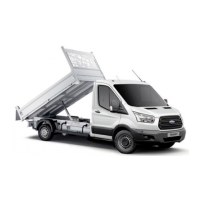Tipper Controls
12
Dual Mode Tailboard: Tipthru/Tipover
A warning triangle or similar devices are permitted to be placed in the
road to warn of a temporary obstruction.
Ensure Tailboard is closed and locked before driving the vehicle.
Never drive the vehicle with the Tailboard in the lowered position.
Vehicle lighting must remain on during loading/unloading through the
hours of darkness or poor visibility.
Tailboard in lowered position obscures vehicle rear lights.
Avoid lowering the tailboard when stationary on the Public Highway.
Temporary obscuration during loading/unloading is permitted
providing other road users are warned of an obstruction in the road.
• Warning Triangle supplied with vehicle.
• Minimum four cones or pyramids.
• Minimum four flat traffic delineators.
• Road vehicle sign (large yellow sheet with a red triangle).
Description:
The tailboard is designed to operate in two different configurations dependant
upon the type of load, the configuration is determined by the operator prior to
tipping. The following guidelines are to enable the operator to identify and apply
the correct configuration before tipping.
Location:
The tailboard is mounted at the rear of the body, located by four latches/pivots.
Two positioned on the upper edge of the board, and two located on the lower
edge. The lower latch is remotely operated by a yellow handle mounted below
the tipper bed to the offside rear, behind the rear wheel fender.
Purpose:
• To safely discharge the payload from the rear aperture of the body.
• To provide restraint for fluid loads only. All loose loads must be restrained
using the load lashing rings provided. The tailboard is not designed to
prevent unrestrained loads from penetrating or bursting the tailboard.
CAUTION
WARNINGS

